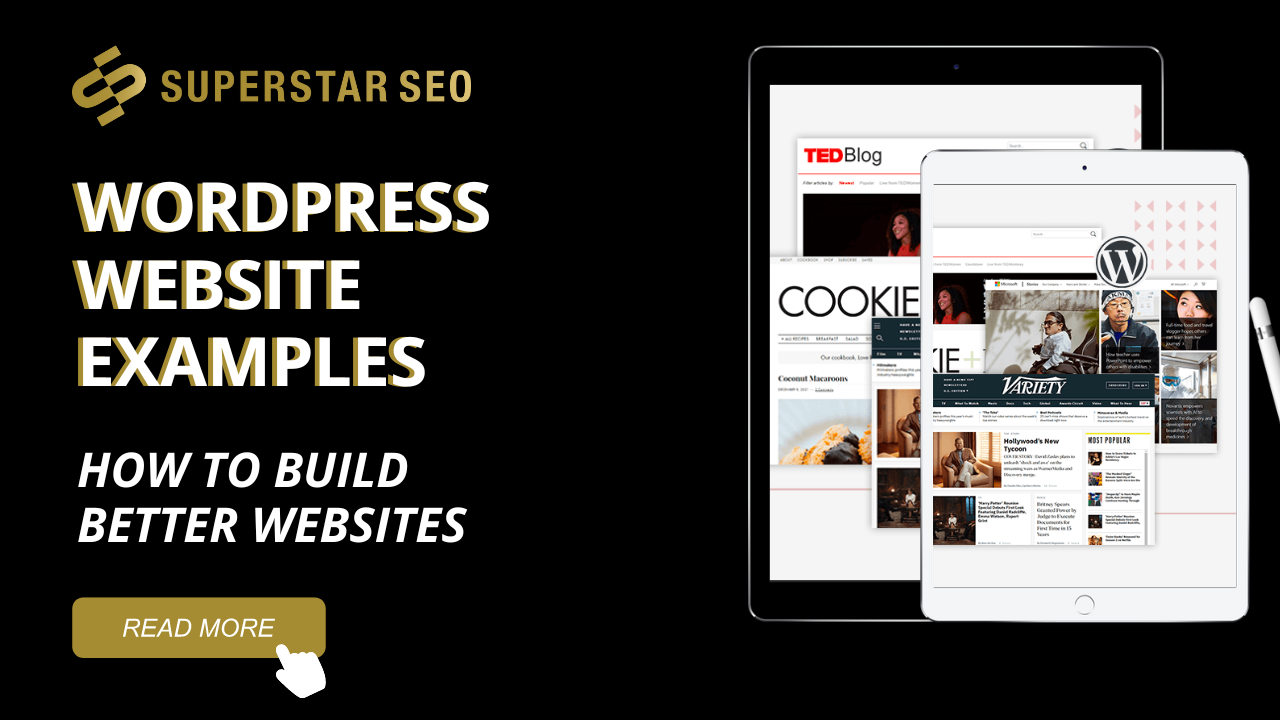WordPress Website Examples: How to Build Better Websites
WordPress is one of the most popular content management systems in the world. However, it’s not as simple to use as many people think it is. In order to build your own WordPress website that will drive traffic and increase sales, you need to understand the ins and outs of how it works, which means using real-life WordPress website examples and mimicking the best practices. Creating a professional WordPress website is now easier and faster with AI Builders, requiring no coding skills.
For that reason, this article will provide you with all the inspiration you need to build better WordPress websites in the years to come!
But, before we go there, let’s see what you need to build a website and how much will it cost?
Why WordPress Dominates the Web
Before we start dissecting examples, let’s take a second to appreciate why WordPress reigns supreme. Flexibility? Check. Customization? Check. User-friendly even for non-techies? Double check. Whether you’re a solopreneur launching your first blog or a corporation rolling out a sophisticated online presence, WordPress has the tools to make it happen.
And here’s the kicker: the platform supports a staggering number of themes, plugins, and integrations, allowing anyone to create a truly unique site. But with great power comes great responsibility—meaning you need to know how to wield WordPress’s potential without turning your site into a chaotic mess.
1. Stunning Blog Websites: Less is More
One of WordPress’s original use cases was blogging, and it’s still where the platform shines brightest. Take Minimalist Baker, for instance. Their WordPress-powered blog is a masterclass in simplicity. Clean layouts, bold fonts, and high-quality visuals make every page a joy to browse.
What You Can Learn:
Stick to a clear visual hierarchy: Minimalist Baker uses large, inviting images paired with easy-to-read text. It’s an intuitive experience.
Focus on speed: Nobody wants to wait for your blog to load. Optimize images and use caching plugins like WP Rocket to ensure your site doesn’t drag.
Prioritize navigation: Categories and tags help readers find what they’re looking for without endless scrolling.
2. Portfolios That Tell a Story
If you’re a creative professional, your website isn’t just a portfolio—it’s your personal brand. Enter Tobias van Schneider, a designer whose WordPress site feels more like an experience than a page. Bold colors, dynamic animations, and seamless transitions make his site unforgettable.
What You Can Learn:
Experiment with custom typography: Fonts can evoke emotion, so don’t settle for generic options.
Use white space wisely: A clutter-free design puts the spotlight on your work.
Incorporate storytelling elements: Tobias’s site walks visitors through his journey, creating a deeper connection.
3. Small Business Sites That Convert
For small businesses, your website is often the first impression you’ll make—and first impressions matter. Look at Blue Lagoon Iceland, a tourism company that uses WordPress to showcase their services in the most stunning way possible. From breathtaking photography to seamless booking features, their site is all about turning visitors into customers.
What You Can Learn:
Prioritize user experience (UX): Simple navigation and fast load times make it easy for visitors to take action.
Invest in visuals: High-quality images can elevate even the simplest layout.
Add trust signals: Testimonials, reviews, and guarantees go a long way in building credibility.
4. ECommerce Excellence
WordPress, combined with WooCommerce, is a powerful duo for building eCommerce websites. Take Pipcorn, an artisanal popcorn brand, as an example. Their WordPress site balances stunning visuals with clear calls-to-action, creating a shopping experience that’s as delicious as their product.
What You Can Learn:
Simplify the checkout process: Fewer steps mean fewer abandoned carts.
Highlight your best products: Feature customer favorites or new arrivals on your homepage.
Leverage plugins: WooCommerce extensions like subscription models or personalized recommendations can boost sales.
5. Nonprofit Websites That Inspire
Nonprofit organizations rely on their websites to drive donations, recruit volunteers, and spread awareness. Charity: Water uses WordPress to tell compelling stories through video, bold imagery, and heartfelt copy. Every element of their site is designed to engage and inspire action.
What You Can Learn:
Make your mission clear: Your purpose should be front and center.
Use visuals to evoke emotion: Authentic photos and videos can tug at the heartstrings.
Simplify giving: Make it easy for visitors to donate or get involved with prominent buttons and forms.
6. Membership Websites Done Right
Membership sites are growing in popularity and WordPress makes building one surprisingly easy. A standout example is MasterClass, a site that offers courses from world-renowned instructors. Their site is sleek, professional, and designed to keep users engaged.
What You Can Learn:
Focus on seamless functionality: Smooth login and payment systems are a must.
Keep members coming back: Gamification elements or regular content updates keep your audience engaged.
Optimize for mobile: Many users access membership sites on-the-go, so mobile responsiveness is non-negotiable.
Importance of WordPress
When it comes to building websites, WordPress stands tall as a popular content management system that’s trusted by millions. Whether you’re dreaming of a professional WordPress website, crafting a stunning portfolio website, or launching a robust eCommerce website, this powerhouse platform makes it happen with ease.
What sets WordPress apart? First, its flexibility and customization. With thousands of WordPress themes at your fingertips, you can create a site that’s uniquely yours, whether it’s a dedicated blog, a sleek business website, or an online store. Plus, with the help of web hosting providers and a seamless WordPress installer, setting up your own website takes just a few clicks.
The WordPress admin dashboard is another gem. It’s user-friendly yet powerful, allowing you to easily install plugins, manage contact forms, and tweak your website’s performance. Need to integrate tools like Google Analytics or design a custom website with a specific domain name? WordPress has your back.
For SEO enthusiasts, tools like Yoast SEO ensure your site’s title and content shine in search results. Whether you’re building websites for personal use or professional ventures, WordPress delivers on all fronts, making it the ultimate website builder for any project.
The Cost to Build a WordPress Website
Building a website in WordPress can be much cheaper than you might think.
With the help of some free plugins and themes, you could have a functional website up and running in less than an hour.
The cost will vary depending on how involved you are willing to get with building your site.
For example, if you would like to build a custom website from scratch, hiring someone might cost upwards of $100 or more (yeah, you read that right), depending on the extent of your needs.
If you need a business website, it can cost you as high as $30,000 per year.
Don’t get me wrong.
WordPress is FREE for anyone to download and build any kind of website without any restrictions.
However, you’ll have to arrange your own custom domain name, web hosting provider and site optimization, which costs money.
We recommend that all our users start small and add more features to your website as your business grows.
This way, you will save money and minimize losses while avoiding overspending.
WordPress.org vs. WordPress.com
We see a lot of people that confuse the two.
WordPress itself has explained the differences.
WordPress.com is a service that helps you build a website with managed hosting.
Meanwhile, WordPress***.org*** is the source where you can download the WordPress software itself to build and maintain a website on your own.
WordPress.com IS a managed host, and in this case, the software takes care of the whole website for you, which is great for newbies.
WordPress.org is NOT a host, meaning you have complete freedom of change and customization of web design.
This is recommended if you are familiar with how WordPress works.
Now that you know the background of WordPress let’s learn how to build a website and see some great WordPress website examples.
Types of WordPress Websites
Blog Website
A blog website is a platform dedicated to publishing articles, posts, and other written content. WordPress excels in this domain, thanks to its built-in blogging capabilities and a vast selection of blogging themes and plugins. With WordPress, users can effortlessly create and manage their blog content, customize the design and layout to reflect their personal style, and foster reader engagement through comments and social media sharing. Whether you’re a hobbyist blogger or a professional writer, WordPress offers the tools and flexibility needed to build a successful blog website.
How to Build a WordPress Website from Scratch?
1. Pick Your Niche for Building Your Website
If you’re new to WordPress, or if you’re looking for a fresh start with your own website, it can be hard to know where to begin.
The good news is that there are many more options than just one.
You can build a website with WordPress in just about any niche or topic.
However, before you dive into the world of niche websites, there are a few things that you should take into consideration first.
Here are some questions to ask yourself when choosing your niche:
What do I want my site’s focus to be? What do I want people to search for when they visit my site?
How much time and money do I have available? Do I have the skills necessary to create something amazing? Can I afford all of those costs?
The narrower the focus of your website, the better you’ll be able to rank for your target keywords.
This means you’ll get fewer visitors, but they will be more targeted and interested in what you have to say than if you had a broader focus on topics like parenting or travel.
2. Choose a Domain Name for Your Website
WordPress itself is a free CMS, but you will need to purchase domains on which to host your site.
The domain name you choose to host your WordPress site will be what people see when they type your URL into their browser.
There are two main reasons why you should choose the domain name for your site:
1) The domain name represents your business or brand
2) It’s easy for search engines to find your website when someone types in your domain name; and
3) You can use it as a link to the root of your website, making it easier for people visiting your site to find their way back home if they’re not sure where they’ve been taken.
You can even use random domain name generators to come up with ideas that are a great choice for your industry or niche, and you can even see if the domain is available for you to buy.
3. Find a Reliable Web Host
For building your website on WordPress, you need to find reliable WordPress hosting services that can provide you with the tools and resources necessary to develop and maintain your site.
You will also need the patience to learn how to use the platform, as well as an understanding of what it takes to run a successful online business.
What about a shared vs. managed server?
Shared web hosting will be OK if you are just starting out and want to keep your costs low, and it’s very popular with WordPress users.
However, if you have the money and security is a huge concern for you, you should go for managed hosting.
Some of the main hosting types are:
Shared Hosting
VPS hosting
Managed hosting
Cloud hosting,
Reseller hosting,
Self-serve hosting, etc.
If you’re unsure, start with shared hosting and go from there.
4. Choose Your WordPress Theme
After installing WordPress, you should think about the theme.
There are a plethora of themes available.
Whether you’re looking for a minimalistic theme or one that offers many customization options, there’s something for everyone.
Thousands of themes are available, ranging from those that are absolutely free to hundreds of dollars.
When selecting a theme, ensure that it makes sense for your site’s topic and the layout and content you plan to publish.
For building your website on WordPress, choose your theme but beware of the nulled ones.
There are a lot of free themes you can use for building your website, but some have been hacked or spammy links, making them unsafe.
Among WordPress theme premium choices, you’ll find a set of ready-made options for various topics.
These include services, fashion, education, food, etc.
Each of them can become an excellent base for the site you want.
6. Install WordPress Plugins
There are hundreds of thousands of plugins available for WordPress, which makes it possible for anyone to create and edit pages without having extensive knowledge about HTML code or programming languages like PHP or JavaScript. To manage and customize these plugins, you will often navigate to the WordPress admin dashboard.
Plugins are a great way to extend your WordPress site and add your desired functionality.
You can search for any type of plugin you want on the repository or check out a comprehensive list of recommended plugins by category.
Once you find a plugin that meets your needs, it will take just a few clicks to install it on your website.
You may not start with many of these plugins, but the longer you use WordPress, the more you’ll want to use them.
For example, if you use Mailchimp or any other email marketing platform, you can easily integrate some WordPress plugins for more functionality.
PDF viewer plugins are a must for your WordPress, and you can choose between the best free and paid plugins as well.
With GPL Root, you can find more than 3256 premium WordPress themes and plugins. When purchasing a membership, you can download an unlimited number of products.
7. Adding Icons to Your WordPress Website
Adding icons to your WordPress website is the perfect way to make it look more professional.
The main reason why most WordPress users don’t do it is because of the fear of coding.
But you should not be afraid of coding.
If you have a basic understanding of HTML, then you can easily make an icon from scratch without any coding skills.
Icons are an important element of your website design.
They are used for navigation, highlighting, and representing your company’s identity.
8. Publish Your WordPress Website
After everything is set, you need to think of your most important pages, including your contact page, the about page, and the privacy and disclaimer page. A dedicated blog page is also essential for structuring your website effectively.
Get these out of the way before focusing on adding content to your site.
These pages serve to protect both you and your site visitors.
After you publish the important administrative pages, it’s time to add interesting content.
Whatever your niche is, you want to make sure you include plenty of compelling content for your readers.
Your pages should be visually rich.
Some excellent WordPress website examples in 2022 include:
Whether you decide to add content daily or monthly, creating a content calendar will help keep you on the right track.
9. Don’t Forget About SEO and Marketing
Marketing your new site means you have to think about social media and SEO.
Make sure your pages have relevant keywords in the title, meta description, and content itself.
You should avoid these common pitfalls if you want to target different languages or countries with your content.
Also, take the time to promote your site in any way possible.
Some options include using social media sites and forums and emailing a regular newsletter.
You may consider guest posting and forums to build your social connections and link popularity.
Moreover, if you’re running a store, it’s important to have an order form on your website to quickly and easily collect customers’ information. Adding an online store to your WordPress site can significantly enhance its functionality and usability.
It’s easy to create and embed them on your WordPress site.
Common Mistakes to Avoid When Building a WordPress Website
Even the best WordPress users can fall into traps. Here are some to sidestep:
Neglecting updates: Outdated themes or plugins can make your site vulnerable to hacks.
Using stock images excessively: Overuse can make your site look generic.
Skipping analytics: If you’re not tracking performance, how will you know what’s working?
Conclusion
The cost of building a WordPress website will depend on your requirements and the level of customization you want.
However, even with the cost, there is still plenty of room for creativity to make your website unique.
The possibilities of building a WordPress website from scratch are endless, with so many free plugins, themes, and tools out there that can help.
However, building a website from scratch requires patience and extreme attention to detail, especially if you want your site(s) to look great and give visitors a perfect experience from the first moment they land on it.
But don’t let this discourage you – launching a clean new site will be worth all the time and effort you put into it, so go ahead and get started right away!





